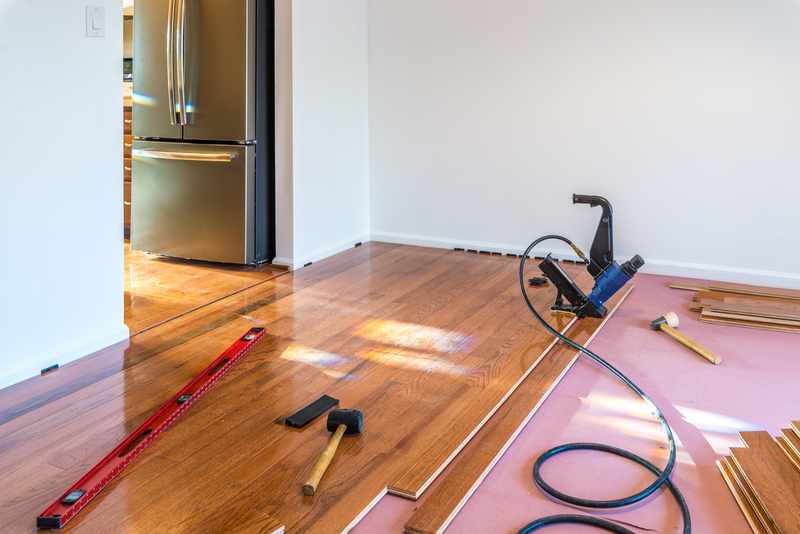Flooring is a defining feature of a home. Hardwood flooring is inviting, beautiful and timeless. Laminate flooring (imitation hardwood) creates a look similar to wood. Need help choosing? There are several factors to consider. The following is a comparison of hardwood and laminate flooring to help you decide which is best for your home.
What is hardwood flooring?
Each board of solid hardwood flooring is made from a single piece of hardwood that’s harvested from slow-growing trees. It’s dense and durable. The look depends upon the species of wood and the surface finish chosen. There are many options with different colours, stains and plank sizes.
What is laminate flooring?
Laminate is synthetic flooring. It’s made from melamine resin and fibre board material. It’s comprised of multiple layers, with the top layer featuring an imprinted image of wood that makes it appear similar to that of real wood. The end result is flooring that looks somewhat like hardwood. It’s available in a wide range of styles, patterns and colours.
Which is right for your home?
There are many factors to consider when choosing between hardwood and laminate.
Appearance:
- Hardwood flooring’s natural texture and deep colours are beautiful, and appealing to many homeowners. Different types of wood, stains and finishes create an abundance of options.
- Laminate often looks like real wood, from a distance. Up close, the imitation is less than perfect.
Size of planks:
- Hardwood flooring planks vary from 1” to 3” to 6” to even 24” wide boards!
- Laminate planks can vary from less than 5” to 7” or more.
Cost:
- Hardwoods that are abundant (oak, maple, ash) are less expensive. More unique species (Brazilian cherry, teak, Brazilian walnut, acacia) have higher prices.
- Laminate flooring can be purchased for a fraction of the cost of hardwood.
Durability:
- Hardwood can last a lifetime! It does need to be protected from flooding. Scratching and wear mean it will periodically need to be recoated. If damage occurs, the floor can be sanded down and refinished. With proper care and refinishing, solid hardwood floors routinely last 100 years.
- Laminate: Laminate flooring is moderately resistant to damage. Once scarred and/or abraded it will need to be replaced as it cannot be refinished or sanded. Laminate floors average about 15 to 25 years of life.
Comfort and Sound:
- Hardwood is hard underfoot and a bit noisy under heels and pet toenails.
- Laminate is somewhat soft underfoot but the hard plastic surface telegraphs the click of heels and pet toenails.
Water and Heat Resistance:
- Hardwood can be damaged by standing water and floods. Too much heat causes boards to shrink and joints to open.
- Laminate is water and stain-resistant, but water getting into the joints between planks can cause the edges and the fiberboard core to swell and chip.
Repair:
- Hardwood: Small imperfections and damage can be sanded and refinished, allowing it to last for years.
- Laminate flooring is not easily repaired. Sometimes individual boards may be replaced but they may not match properly.
Care and Cleaning:
- Hardwood floors are simple to keep. Sweep or vacuum and damp mop with wood cleaner. No need to polish and/or wax.
- Laminates are also easy. Vacuum or broom. Then damp mop with laminate floor cleaner. No waxing is necessary.
Installation:
- Hardwood requires installation by professionals. Solid hardwood needs to be nailed or glued to the substrate.
- Laminate is favoured by DIYers as it is easy to install. Planks click together at the edges with no need for fasteners or glue. It floats over a thin layer of foam underlay.
The room in which you intend to install it:
- Hardwood is perfect for low-traffic rooms (bedrooms, dining rooms, sitting rooms) but unsuitable for damp rooms (basement, bathroom).
- Laminate flooring works well in rooms with a lot of sunlight as it does not fade easily. It’s moisture resistant so works better in bathrooms than hardwood. Laminate flooring is recommended for areas that are regularly used by children and pets.
Resale Value:
- Hardwood: Realtors claim that hardwood flooring makes a home easier to sell and helps a house sell quickly. Though the ROI of flooring is difficult to measure, real estate experts estimate that homeowners recover approximately 106% of their costs by installing new hardwood floors in their home before selling.
- Laminate: Laminate flooring is well-known for its low maintenance and ability to withstand high amounts of traffic. It’s resistant to staining, indentation and scratches, making it one of the most popular pet and kid-friendly flooring options for homeowners. It’s essentially a hassle-proof flooring option for the modern family. High-quality laminate floor ranks below solid hardwood for resale value but laminate commands a higher resale value than vinyl flooring.
Both hardwood and laminate floors have their merits and pitfalls. Hardwood is more expensive but easier to repair, lasts a long time and boosts resale values. It’s a great investment. Laminate flooring is more affordable, quite durable, is easily installed but repairs often involve redoing the entire floor. Laminate flooring will never pass for real hardwood. Nothing approaches the beauty of an authentic hardwood floor! However, there are situations (pets and kids, damp conditions) in which laminate functions well.
Looking for a selection of beautiful hardwood floors? Contact Smith Bros. Floors, one of Canada’s oldest hardwood flooring companies, family-owned and operated. We use industry-leading flooring and finishes because we want your flooring to last! With a tested crew of installers and finishers and a lifetime guarantee on workmanship and longevity, Smith Bros. quality cannot be beaten! We provide exemplary customer service, from site visit, to quote, to installation and follow-up. Call us at 403-255-7791 for a free consultation.
